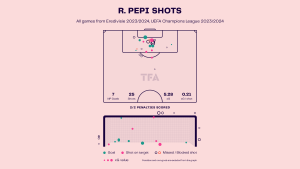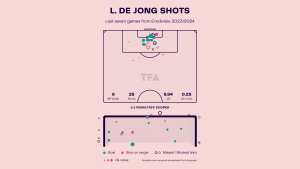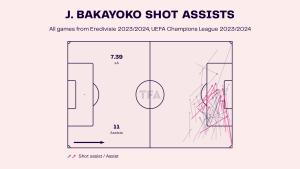After starting the Eredivisie campaign with two wins and two clean sheets in their opening two games, Ajax welcomed Vitesse as they made it three wins from three. For the third consecutive game, a red card was given in an Ajax fixture, and for the second time this season, it was given to an Ajax man. Despite this, they answered Vitesse’s second half equaliser with a match winner, ensuring that their Eredivisie and Champions League qualification hunts are still fully intact. Vitesse, who have been known to bring in young players on loan from the Premier League, and in particular, Chelsea, proved to be a tough opponent, and took the fight to Ajax, especially after the red card. This match report will provide a tactical analysis of Ajax’s approach, with a close analysis of tactics on which key elements enabled them to pick up another win.
Ajax Line-up
Erik ten Hag sent his side out in a 4-3-3 formation, a slightly different shape to their regular 4-2-3-1. Nicolas Tagliafico returned from suspension to play at left-back, with Daly Blind and Perr Schuurs combining in the heart of the defence. Mohammed Kudus operated as the deeper midfielder, with Quincy Promes and Edson Alvarez lining up next to each other, a partnership with great defence-to-attack balance. Antony and Dusan Tadic occupied the wings with Zakaria Labyad leading the line. Following the red card to Alvarez just before half time, Ajax switched to a 4-3-2 – maintaining the same shape in defence and midfield, but with two central strikers. Visitors Vitesse lined up with a 3-4-1-2 shape, aiming to overload the midfield while still having firepower up front.
Ajax: Off-the-ball
Ajax are no strangers to working hard and strategically when the opposition have possession. They also have the ability to be versatile in how they approach these situations.

This method is particularly effective. Vitesse had just started to try and play out from the back when Ajax squeezed up the field. Labyad, the closest player to the man on the ball, applied intense pressure to limit the time on the ball. The five potential passing options in the Vitesse half were effectively eliminated as Ajax marked them up, man-for-man. Passing to any of those teammates would be extremely risky with a high chance of Ajax taking possession in a dangerous area, forcing the Vitesse man to go long to avoid this risk. The long ball on this occasion deflected off Antony, resulting in a Vitesse throw – Ajax proceeded to mark man-for-man again, giving Vitesse the same issue.

Above is another classic case of Ajax pressing. Regardless of how they press in other areas of the pitch, they almost always close the goalkeeper down, not allowing the opponent to build any safe possession in their own half. This scenario sees Tadic coming in from the left win to hurry the keeper, with Antony and Labyad occupying the two close defenders, not allowing the keeper to make the pass to them. Like the first example, and so many others, this forces a long and rushed ball up-field, which is collected by Mazraoui at right-back, giving Ajax another chance to go forward.
This made it extremely difficult for the visitors to build any attacking momentum as they were limited in options going forward by an energetic Ajax side. Their energy, however, was not as consistent or intense in the second half, following the dismissal of Alvarez.

As we can see in the analysis above, Ajax adopted an approach that was similar to that of the opening game of the season – another game they found themselves down to 10 men. The midfield unit would ignore any pressing urgencies to mark the Vitesse players in their zone, eliminating them as passing options. Despite having the disadvantage in terms of numbers, Ajax were still confident of a victory, which is why they left the two strikers/highest players up field each time Vitesse had possession in this fashion. This gave Ajax an immediate outlet for when a turnover in possession occurred, meaning they could transition into attack very quickly.
However, this does leave the Vitesse man on the ball with a lot of time and space, under no immediate pressure – Ajax’s positioning and marking does make it difficult for them to find any gaps to exploit.
Ajax: Attacking Strategy
Typically, we expect Ajax to be a side that dominates possession, dictating the tempo in the opponent’s half as the opposition sit deep in a defensive set up. But that’s not always the case, they are sometimes required to explore alternate attacking avenues, which is something they are prepared for, as seen in the two-part analysis below.

This first part shows how deadly Ajax can be at splitting open an opposition in very quick time. Prior to the moment above, Ajax had smoothly progressed the attack from the goalkeeper, through the midfield, to the location above, in a matter of seconds, using just a couple of passes. This allowed them to bypass any Vitesse midfielders that weren’t already back defending. Furthermore, Vitesse’s defensive shape above isn’t fully organised, which is why Noussair Mazraoui was able to burst into the space near the byline and receive the pass.
Coming back to the poor defensive shape of Vitesse, not only did it allow Mazraoui to get into a dangerous wide position, it eventually leads to Ajax taking the lead, as the second part of this analysis shows below.

As we can see, Vitesse have four bodies in the box to try and deal with this attack. The defenders in the box are actually positioned well in the image above (maybe the right-back should a little deeper or close to Tadic), but the fault lies with the midfielder just outside the D, as he fails to pick up Quincy Promes at the edge of the box. Unmarked and in a dangerous position, Promes struck the ball first time across the keeper following a perfect ground pass from Mazraoui. As poor as the defending in this scenario was from the visitors, credit must be given to Ajax for conducting such a dangerous attack so quickly and effectively.

The analysis above gives us a clearer idea of how Ajax would approach an attack under more usual circumstances – controlling possession in the opposition half. In truth, the game was just as close as the scoreline suggests with Ajax actually having less possession (45%) and shots (18) – but it’s how Ajax conducted themselves on the ball when given the chance. If we again compare Ajax’s shape here to how we would usually see them in the attack, we some differences immediately. Firstly, the shape and distance between the midfield three play a different role. Usually, the two midfielders not on the ball would drop into an area where they could receive the next pass. However, due to the numbers in the Vitesse midfield, very little central space was available, meaning the two remaining Ajax midfielders would position themselves to move/occupy a Vitesse player. Another major difference is the shape of the front three, who again are acting on the positioning and shape of Vitesse.
With a back three, there will be little use in Ajax playing with a wide shape, as they would only be picked up by the wing-backs, giving the central defenders less to worry about. By occupying all three central defenders, it causes them to tighten up, leaving space for the Ajax full-backs as the wing-backs would have to retreat to fill the gaps. With this kind of variety of width, it gave Ajax a number of different options to progress the attack. In this example, Mazraoui received the ball at right-back, with Antony, the right-winger, simultaneously moving into a wide area before the two executed a one-two sequence.
With Ajax playing the second half with 10 men, and part of that half was dedicated to retaking the lead, Ajax varied their style of attack. In some cases, they would continue to commit a high number of players to attack, which would leave them at risk of a counterattack – which is why they only used it on occasion. Perhaps their best way of getting forward was the execution of quick combinations through the midfield area, often in transition into attack, which allowed them to get at the Vitesse defence with pace.

The analysis above sees Ajax looking to hit Vitesse quickly after the hosts defended a long ball approach from the visitors, with Mazraoui picking up the ball on the half-way line. While he could’ve preserved possession and found a safe pass to allow Ajax to get higher up the pitch as a whole unit, his intentions were clearly to set Ajax off on the break in a transition. With a direct and precise pass into the feet of Quincy Promes, Ajax had already bypassed Vitesse’s midfield. On receiving the ball, Promes turned so his back was facing the Vitesse goal, allowing him to bounce a first time pass back towards Tadic, who had acres of space around him to work within.
This type of move allowed Ajax to break quickly into dangerous positions without risking being victims of a Vitesse counterattack as they had the numbers back. The pass back to Tadic meant the Vitesse midfield had to engage with the Serbian, opening up spaces in other areas in midfield to exploit.
Conclusion
While the red card certainly had an impact on the approaches of both Ajax and Vitesse, Ajax dealt with the added pressure with composure and wisdom on the most part. As mentioned previously, however, Vitesse registered more shots on goal than Ajax and held more possession throughout the game. The formation of the visitors worked well for them in the sense that it allowed them to play some attractive football in midfield areas while also making it difficult for Ajax to have comfortable possession in such areas. Out of Vitesse’s 25 shots, 14 were outside of the box, which can be looked at in two ways. Firstly, Ajax’s defence was organised to a level that forced 14 shots from outside the area, frustrating the visitors. On the flip side, initially, it may look like Ajax weren’t as organised as usual since they allowed 11 efforts on goal from inside the area, but the majority of these came from set-pieces, meaning Ajax were rarely broken down or penetrated.
Despite not dominating the game in their usual fashion, Ajax played with confidence and intent on the ball, not to be satisfied with a point at home – even after the red card, they were in search of a winner to take all three points.










